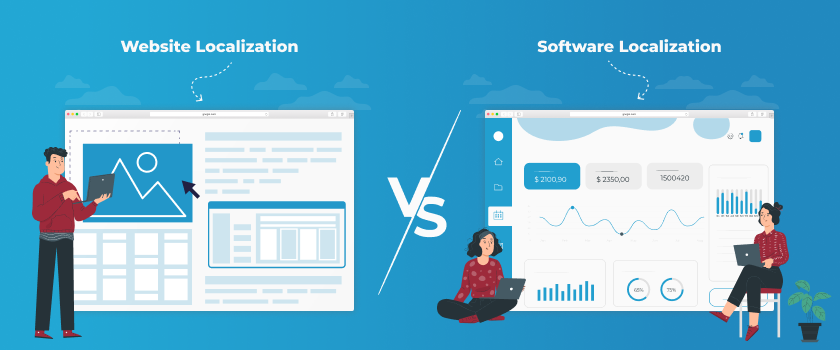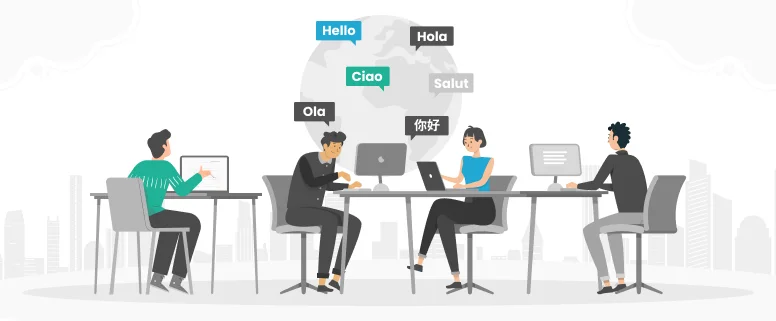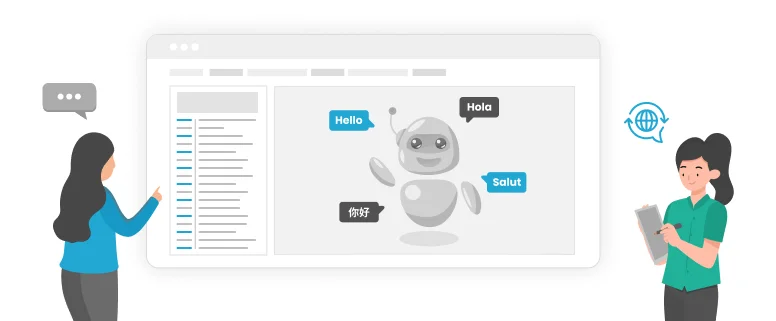Website and software localization is impacting all aspects of our lives due to digitization. At present, consumers are more aware than before. To give them seamless services, it is very essential to go for website and software localization. They provide customer-pleasant user experience despite cultural and regional intricacies. There is fierce competition in the global market. Therefore, by localizing your website and software, you can easily attract global customers from the international market.
A report by CSA research stated that 76% of people that like to shop online prefer products that are in their native language. 65% of people go for native content, no matter if it is of bad quality. Moreover, 40% like shopping through platforms in their local language. The top-notch companies of the world realize the importance of localization services to attract customers, no matter in which part of the world they reside.
Difference between a Website and Software
Website, as the name depicts, is a collection of web pages on the bandwidth. It is operated by a single person or organization. People visit it with the help of a browser.
The software consists of a set of programs or instructions that tells the computer how to operate. It is designed to offer different functions. Let’s have a look at the difference between website and software
- The website generally runs on a server, whereas software’s runs on local computers and cell phones.
- The website consists of different web pages that are linked together, whereas software consists of a set of data and instructions.
- A website is a collection of web pages that operates under a single domain name. On the other hand, the software is an operating system or a program that is operated by a computer.
- Features of websites are product descriptions and visuals, intuitive designs, and easy navigation, and the features of software include portability, efficiency, functionality, and maintainability.
- List of websites comprises YouTube, Google Search, Amazon and Wikipedia. On the contrary, the list of software includes Microsoft internet explorer, adobe acrobat professional and google chrome.
- The websites help in market expansion and give insights into products and services to the customers. Moreover, it helps to enhance your credibility and helps in the exchange of information. On the contrary, the software helps to increase your productivity, enhances your business potential, and increases productivity.
- Websites are designed to reach more consumers in the digital world. Software’s are designed to fulfill customer requirements.
- Websites are written in scripting language whereas software’s are written in a programming language.
Native Language Vs Second Language
You can make your business successful by launching a website and software in a language that is understood by the masses. Approximately, there are a whopping 4 Billion internet users. Out of this enormous number, 3.4 million people consider languages other than English their native language.
To your surprise, there are 380 million native English speakers around the globe that learn English as a second or third language. The United States, which is the superpower of the world, is no exception to it. Although the US has no official language there are a whopping 300 different languages spoken alone in this country.
Most people might speak the English language but the rational decision is to sell your products and services in the language in which people can understand products and services and feel native and comfortable. Here comes the importance of website and software localization.
According to the report by the Common Sense Advisory, businesses can boost their sales if they go for proper localization of their websites. People give preference more to their native language while shopping online. Moreover, people also want after-sale services and customer support in their native language.
Difference Between the Translation and Localization
The translation is about changing your content from the source language into the target language while keeping syntax and grammar rules in view. It keeps each language’s standards and guidelines in view. The translation is used mainly in rewriting medical and business documents, technical publications, manuals, literature, scientific journals and many more.
Translators must be very careful in providing precise and accurate translation services, so that the original message of the source language cannot deviate from its intended message. On the other hand, localization is a step ahead of translation. It changes your text according to the local target market. Localization is mainly used for websites, software’s, multimedia content, voice overs, and video games.
Localization means providing services while considering regional and cultural intricacies. For example, if you need to translate a website or software into the Spanish language then you must check the Spanish lexicon spoken in Mexico, Spain, and Argentina. It is the same if you use different English for US customers and Canada because both countries speak different dialects of English. To market your website and software you must include localization in marketing strategy.
In short, translation is a part of the localization process. For impeccable localization services, you must hire a professional translation company. Professional translation company has a team of native translators that are born in the same region. Therefore, they know about local and cultural differences and provide you with impeccable localization services.
The only simple translation is not enough for your website and software to get success in local markets. You must localize your content to win the trust of the local target market. Selling in a foreign market is not only about mitigating the communication barriers. It is about designing your website and software according to the preference of the local market.
Going beyond translation is important to mitigate cultural intricacies because at times it becomes difficult to understand the intended message. KitKat, for instance, translates their slogan into the Japanese language when they launch their product in Japan. They changed the slogan Have a break, have a KitKat into Kitto Katsu which means to win. This localization strategy worked well for KitKat for the Japanese market.
Localization Covers all Cultural Expectations
To penetrate foreign markets, you must localize your website and software according to the local culture. Simultaneously, you need to keep your business voice unique to identify your business from other brands. Coca-Cola maintains a singular message worldwide and alters its campaigns with the help of localization for each local market. Everyone knows the colours of Coca-Cola, whether they are living in Italy or China.
However, their marketing strategy varies in each country according to customers’ expectations. In China, the majority of global companies change their products’ names to resonate with the target market. Coca-Cola named itself Kekou Kela. When it is translated, it states delicious happiness.
In this way, Coca-Cola conquers the Chinese market. Localization is all about cultural expectations. For this, you don’t only need to translate your web and software you need to reshape it. In this way, the target market will feel that you have developed a web especially for them.
What is Software Localization?
Software localization is the conversation of your software according to the requirements of a specific language and culture. This process is tedious and includes alteration of text, user interface, images, and multimedia. Software that is successfully localized gives the feeling that it is designed especially for the audience of the specific region.
Do you want to know why it is important? Assume that 45% of the world’s top downloads are from China, so you will never miss a chance of hitting the massive market without localizing the software.
What is Included in Software Localization?
The process of software localization requires modifying code, online help, string messages, legal requirements and technical specifications and other important aspects of software according to the global market in mind. Moreover, it is also necessary to alter the format of numbers, dates, time and currencies.
You also need to check the compatibility of fonts as it fits in the required space or not. You must translate your software into languages using alphabets that are other than written in the source text. If you translate English software to Arabic and Japanese then the entire interface will be different.
The content and buttons should also navigate easily. All the source content should be translated in a way that it can be translatable. This includes both the technical part which is coding and the creative part which is the user interface.
What is Website Localization?
Website localization is the process of modifying a website that resonates with the target market. The target markets that speak a different language and have distinct cultural values. It is a tedious process. The technical process includes coding the site while using appropriate alphabets and symbols.
It makes a payment process easy to handle in a specific currency. The linguistic side includes converting language from one to another while keeping cultural sensitivities in view. Cultural references should not be used on the website because something that is considered good in your culture might be considered offensive in other cultures. Moreover, phrases and idioms should not be used because they are difficult to translate into another language.
Global website localization finishes here. You also consider images and colours. Don’t use infographics that are considered unlucky in another target market. Use images and symbols that identify the specific nationality.
Localization Improves the On boarding on your Website and Software
The quality of your website and software will impact the adoption of your website and software. If you can attract the customers and they start using software or websites then you must provide the solutions according to their requirements. On the contrary, if you onboard customers badly then they will not be able to know the critical features of your services.
Potential customers will use your website, if it is in their native language. If they are browsing, they become customers. In the same way, people will download software if it is in the language that they understand. If people are unable to understand the features of the website or software, they will leave without making any purchases. Moreover, customers want customer support in their native language.
Increases User Satisfaction
Localizing your website and software will increase user satisfaction. The customers will keep using the website and software if they feel that they are according to their requirements. If potential customers are happy with your digital services, they keep on using them. On the contrary, if the customer is not satisfied, he will log off from the website or software. By localizing your software, and website, you can increase customer satisfaction because they can understand without any communication and cultural barriers and use your services easily.
Wrapping Up
The best way to penetrate the foreign markets is by localizing your software and website. For impeccable localization services, you must hire a professional translation company. They know all the technicalities that are involved in website and software localization and provide services accordingly. Are you ready to localize your website or software?
For More Information:
What is Website Localization
6 Easy Steps to Website Localization
7 Best Practices To Follow For Website Localization
Top 10 Languages for Website Translation
What Matters When doing Website Translation and Localization
How many people speak English in the World?
English Speaking Countries in Africa
English Speaking Countries in Europe
My Opinions about Learning English
Hardest Languages to Learn in the World
Top 15 Languages of the Future



